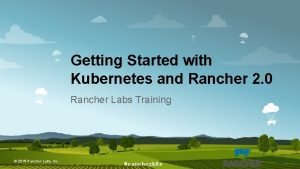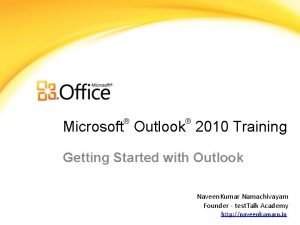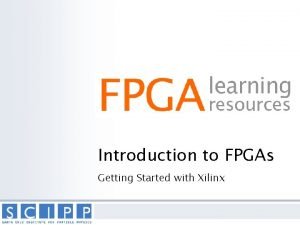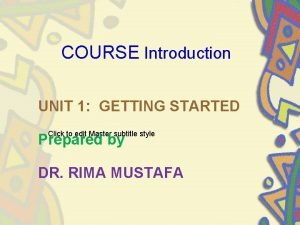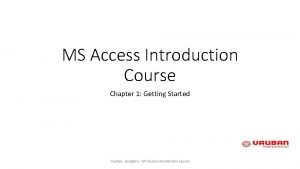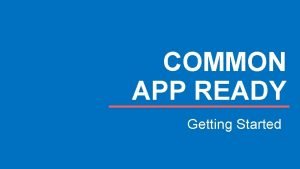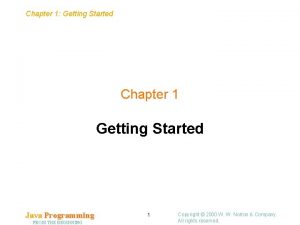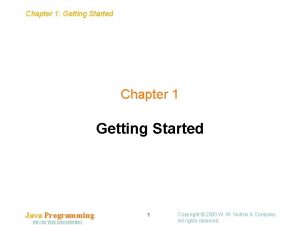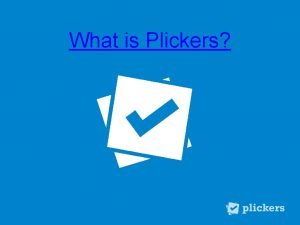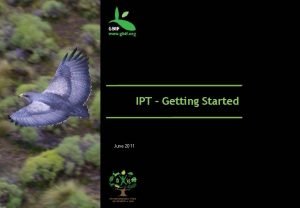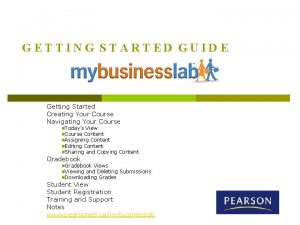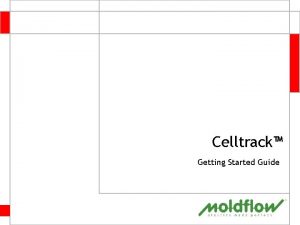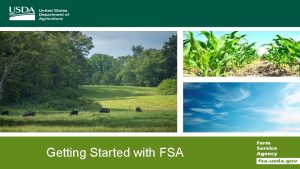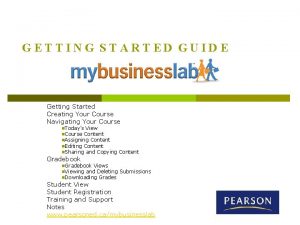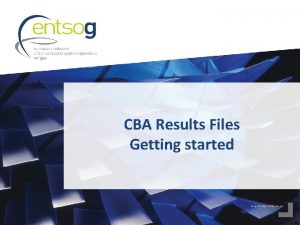Getting started with the Program Standards David Lawrence





















- Slides: 21

Getting started with the Program Standards David Lawrence EHS III, Fairfax County Health Department Paul Stromp RS/REHS, Lake County General Health District Cady Hutchinson RS/REHS, Lake County General Health District Stephen Hughes MS, REHS, FDA/CFSAN

What are the standards? q. Define a highly effective and responsive food program q. Provide a foundation which all regulatory programs can build through continuous improvement q. Provide a framework that incorporates traditional and emerging approaches to food safety q. Reinforce good retail practices q. Encourage agencies and industry to focus on factors that contribute to foodborne illness

Nine Program Standards 1 - Regulatory Foundation 2 -Trained Regulatory Staff 3 - Inspection Program Based on HACCP Principles 4 - Uniform Inspection Program 5 - Foodborne Illness and Food Defense Preparedness and Response 6 - Compliance and Enforcement 7 - Industry and Community Relations 8 - Program Support and Resources 9 - Program Assessment

How to move forward after enrollment q. Complete initial self assessment q. Submission of FDA forms q. Develop a project plan with time lines q. Begin work on easiest Standards to meet q. Self assessment and verification audit of Standards met q. Submission of FDA forms q. Reach out to others working on the Standards to share resources

Standard 3 Standard 4 Standard 1 1 Standard 2

Standard 1 Regulatory Foundation 1. 2. 3. 4. Includes provisions for: Public health interventions in current edition of Food Code Control measures for foodborne illness risk factors Good Retail Practices Compliance and enforcement -Are the regulatory requirements for food establishments based on sound science and good public health interventions? -Does the agency have the statutory authority to effectively enforce its requirements?

Standard 2 Trained Regulatory Staff 1. 2. 3. 4. 5. 5 Step Training and Standardization Process Curriculum courses 25 joint inspections 25 independent inspections Standardization process 20 CEUS every 36 months -Does the program ensure that personnel are properly trained and standardized in the essential elements of food safety and effective inspection and enforcement principles? -Does the agency have certification to verify the training?

Standard 3 Inspection Program Based on HACCP Principles 1. 2. 3. 4. 5. 6. IN/OUT NA/NO Form Risk categories Inspection frequency Corrective action policies Variance request policies HACCP plan policies -Do facility inspections focus on the key foodborne illness risk factors? -Are out-of-control risk factors corrected using Active Managerial Control?

Standard 4 Uniform Inspection Program Quality assurance program that ensures: 1. Inspection quality 2. Inspection frequency 3. Uniformity among staff. -Does the agency have a quality assurance program that promotes the uniform interpretation and application of regulatory requirements and policies of regulations and policies?

Standard 5 Foodborne Illness and Food Defense Preparedness and Response 1. 2. 3. 4. Surveillance Investigation Response Review of food related incidents and emergencies -Are reports of foodborne illness and injury investigated, analyzed, and documented in an effective manner? -Does a coordinated approach for investigating foodborne illness and sharing of information exist?

And the fun continues…

Standard 6 1. 2. 3. 4. Compliance and Enforcement Step by step enforcement procedures Inspection form Document compliance and enforcement Identify major risk factors -Do agency compliance procedures result in timely correction of out-of -control risk factors? -Are appropriate enforcement actions taken when necessary and are they applied consistently?

Standard 7 Industry and Community Relations 1. 2. Industry and Consumer Interaction Educational Outreach -Does the program foster communication and information exchange between itself and the regulated industry, consumers, and other stakeholders? -Does the industry have an appropriate opportunity to contribute to the design and implementation of a comprehensive retail food safety program? -Are there a sufficient number of effective food safety training and education programs offered to the industry?

Standard 8 Program Support and Resources 1. Staffing level (One 2. Inspection Equipment Administrative Program Support 3. FTE for 280 -320 inspections) -Does the program have the consistent funding, staff support, and equipment necessary to support an effective risk-based food safety program?

Standard 9 Program Assessment 1. 2. 3. Risk factor study Analysis of data Intervention strategy for risk factors identified -Does the program strive for excellence in the services it provides? -Does the program employ the “best practices” to achieve a reduction in foodborne illness risk factors? -Are clear, quantifiable performance measures used to assess the success of food safety efforts at the retail level?


How to move forward after enrollment q. Complete initial self assessment q. Submission of FDA forms q. Develop a project plan with time lines q. Begin work on easiest Standards to meet q. Self assessment and verification audit of Standards met q. Submission of FDA forms q. Reach out to others working on the Standards to share resources

NACCHO q. Example Policies and Forms on NACCHO Voluntary Program Standards site http: //www. naccho. org/topics/environmental/foodsafety/retail/example-policies-and-forms. cfm q. Crosswalk on Public Health Accreditation and Retail Program Standards q. Key Informant Interview Summary Report q. Sharing Sessions

FDA q. FDA launch page: http: //www. fda. gov/Food/Guidance. Regulation/Retail. Food. Protection/Program. Standards/default. htm has links to: § § § Retail Program Standards Listing of Enrolled Jurisdictions Clearinghouse Workgroup Q & A Crosswalk to Public Health Accreditation Sharing Sessions Funding & Grants/Cooperative Agreements

Collaboration q. Lake County created an ongoing Program Standards Forum for other Northeast Ohio Agencies to share resources and experiences q. Fairfax County and adjacent health districts in Northern Virginia work together q. Mentorship (formal and informal)

Questions
 The secret of getting ahead is getting started
The secret of getting ahead is getting started Getting started with vivado ip integrator
Getting started with vivado ip integrator Getting started with unix
Getting started with unix Splunk e learning
Splunk e learning Rancher get started
Rancher get started Getting started with excel
Getting started with excel Microsoft outlook 2010 tutorial
Microsoft outlook 2010 tutorial Counter code
Counter code Getting started with lua
Getting started with lua Unit 1 hobbies
Unit 1 hobbies Local environment getting started
Local environment getting started Unit 1 getting started
Unit 1 getting started Linkedin getting started
Linkedin getting started Getting started with vivado
Getting started with vivado Dr jeffrey roach
Dr jeffrey roach Getting started with ft8
Getting started with ft8 Unit 3 getting started
Unit 3 getting started Unit 1 getting started
Unit 1 getting started Poll everywhere register
Poll everywhere register Android development getting started
Android development getting started Getting started with access
Getting started with access Getting started with eclipse
Getting started with eclipse




